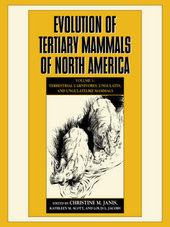
|
Evolution of Tertiary Mammals of North America: Volume 1, Terrestrial Carnivores, Ungulates, and Ungulate like Mammals
Paperback / softback
Main Details
| Title |
Evolution of Tertiary Mammals of North America: Volume 1, Terrestrial Carnivores, Ungulates, and Ungulate like Mammals
|
| Authors and Contributors |
Edited by Christine M. Janis
|
|
Edited by Kathleen M. Scott
|
|
Edited by Louis L. Jacobs
|
| Physical Properties |
| Format:Paperback / softback | | Pages:708 | | Dimensions(mm): Height 279,Width 210 |
|
| Category/Genre | Palaeontology |
|---|
| ISBN/Barcode |
9780521619684
|
| Classifications | Dewey:569.097 |
|---|
| Audience | | Professional & Vocational | |
|---|
| Illustrations |
219 Line drawings, unspecified
|
|
Publishing Details |
| Publisher |
Cambridge University Press
|
| Imprint |
Cambridge University Press
|
| Publication Date |
17 March 2005 |
| Publication Country |
United Kingdom
|
Description
This book is a unique compendium and synthesis of the cumulative knowledge of more than 100 years of discovery and study of North American tertiary mammals. The potentially most valuable contribution of this book is the detailed information of the distribution in time and space of each species at fossil localities, recorded in a uniform scheme, so that each chapter provides the same level of information. Thirty six chapters are devoted to a particular family or order, written by leading North American authorities, including discussion of anatomical features, systematics, and paleobiology. Three introductory chapters summarize information on the geological time scale, Tertiary vegetation, and Pleistocene events, and four summary chapters integrate systematic and biogeographic information for higher taxa. This book will serve as a unique data base for continuing studies in faunal diversification and change, and for questions such as how changing biogeography and climates influenced the evolution of mammalian communities. It will be an invaluable addition to the libraries of paleontologists and zoologists.
Reviews'The 'Overview' consists of three concise chapters covering the basics of the Tertiary world with respect to its chronology, climate, geography and vegetation and the subsequent fauna of the Pleistocene. It is my opinion that these chapters should be required reading for any new graduate student undertaking research on North American Tertiary mammals. Context is essential to understanding the importance of our work, and you cannot go wrong with such a concise but detailed look at these three essential aspects of the setting. ... As someone whom has actively and regularly used this book (usually copies owned by libraries or by others) ever since it was first published (when I was an undergraduate just beginning serious regular research), I can honestly say that this re-issue will prove to be a wise move on the part of the publishers and a much-needed opportunity for students and all of us to get our hands on this wonderfully organised resource.' B. L. Beatty, www.PalArch.nl
|